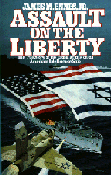
Initially we of the ship's crew were concerned about being relatively close to a shooting war, even though our position put us always more than 12-1/2 miles from shore, clearly in international waters and well away from any action. We had asked for a destroyer escort, but this request was rejected by the Sixth Fleet Commander who said that we did not need protection because we were on a peaceful mission in international waters. In any case, he said, in the unlikely event of an accidental attack, Sixth Fleet aircraft could be overhead in a few minutes.
By the time we arrived, however, Israel had destroyed nearly every aircraft belonging to any of her enemies. Now they were only mopping up, chasing the retreating Arab armies back across the desert. There seemed little reason for further concern.
We were assigned to patrol a dog-leg-shaped track perhaps 100 miles long near the Egyptian-owned Gaza Strip, roughly from Rafah to Port Said. We were to steam at our slowest possible speed, about five miles per hour.
Initially we had some concern for our safety, because the Arab countries were blaming the U.S. for the war. Many had broken diplomatic relations with America and some were claiming that the attacks on their airfields had been by American aircraft from the U.S. Sixth Fleet.
If we had any fears for our safety, however, these quickly vanished. Much of this coast area had been captured by Israel only hours before our arrival. Israel was our friend. Israeli aircraft had circled us throughout the night (identified by their radar characteristics), and now, with daylight, they came closer and we could see the Star of David markings. Often they came so close that we could see the pilots in their cockpits and exchanged friendly waves.
I was the officer-of-the-deck on the bridge during this period, and following each visit our leading intercept supervisor, Chief Melvin Smith, would come up to the bridge and ask if I had seen the aircraft's markings to confirm his own electronic observations: "Not to worry," he would say, "Each time they circle we can hear the pilot telling his headquarters that we are an American ship."
That was comforting to everyone on the bridge. Yet, taking no chances, I ordered the quartermaster to haul up a new flag, with bright and clear colors, and instructed signalmen and lookouts to assure that the flag never wrapped around the lines or mast making it difficult to see even for a few seconds. I was pleased to see that we had a steady breeze across the deck, always more than enough to hold the flag out so that it could be seen clearly by the Israeli pilots.
Below, our intercept operators worked at their task. Usually our orders are very clear. This time, apparently because of the limited time to prepare, our orders were unusually vague and general. We were to collect intelligence from electronic sources in the area. Little more than that.
During our brief stopover in Rota, Spain, however, we had taken aboard several technicians and linguists sent by the National Security Agency especially for this mission. These men had been specially briefed on their assignment. They were trained in Russian and Arab languages; not a Hebrew linguist among them. And while the assignment remained a vague and general one, their primary interest was not the Israelis or even the Arab side of this war. The primary concern of these men was to learn more about several Soviet TU-95 bombers that had been stationed in Egypt by the Soviet government. The assignment: find out whether the aircraft were controlled by Egypt, as both governments claimed, or were in reality merely Soviet long range bombers stationed on Arab soil and under Soviet control.
During the morning and early afternoon of June 8, these several technicians sat with our regular radio intercept operators, searching the radio spectrum, looking for Russian language broadcasts from within Egypt. Meanwhile, Israeli aircraft continued to circle us about every 40 minutes, a total of seven visits during daylight. These airplanes circled our ship 13 times. And on every occasion Chief Smith came back up to the bridge to tell me that he had identified them; they were Israeli, they knew we were friendly, and they had so informed their headquarters.
At 2:00, radar operators on the ship's bridge detected more approaching high speed aircraft, flying low, coming from the direction of Tel Aviv. Apparently these were more of the same aircraft that had been visiting us all day. At the same time our men detected three small surface craft, later determined to be Israeli torpedo boats, just as they came across the visible horizon 16 miles away.
In the radio intercept spaces, our intercept operators were getting lucky too. "We got em, We got em," one of the men yelled as he raced across the crowded room to tell Chief Smith that they had identified Soviet pilots talking to Moscow in the Russian language from the bombers that were supposedly owned and controlled by Egypt. Now there was proof that these were not Egyptian airplanes at all. That was a ruse. These were Soviet long range bombers stationed dangerously close to Europe, America, and the free world. An important part of Liberty's mission, perhaps the most important part, had been accomplished.
Read or download audio chapter from "Assault on the Liberty" describing the air attack.
 Return to the USS Liberty home page
Return to the USS Liberty home page